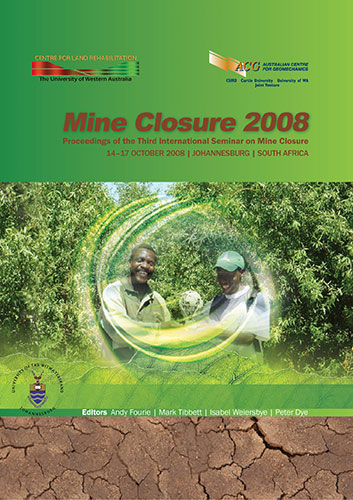Commitment, Experience and Teamwork — The Key to a Successful Mine Closure Works Programme at Tanami Mine Site

|
Authors: Potts, RT; Lacy, HWB |
DOI https://doi.org/10.36487/ACG_repo/852_35
Cite As:
Potts, RT & Lacy, HWB 2008, 'Commitment, Experience and Teamwork — The Key to a Successful Mine Closure Works Programme at Tanami Mine Site', in AB Fourie, M Tibbett, I Weiersbye & P Dye (eds), Mine Closure 2008: Proceedings of the Third International Seminar on Mine Closure, Australian Centre for Geomechanics, Perth, pp. 385-393, https://doi.org/10.36487/ACG_repo/852_35
Abstract:
Tanami mine site, located in one of the most remote and inhospitable locations of Australia, is undergoing one of the largest mine closure works programmes seen in Australia over the past five years. The mine area and its satellite pits are scattered over an area of 100 km in length and 1800 km2 within the Tanami Desert of the Northern Territory, approximately 670 km north-west of Alice Springs, and is one of the most remote mines in Australia. The majority of the project area occurs within the Central Desert Aboriginal Land Trust, administered by the Central Land Council (CLC). The site is a historic mining area which was mined for gold from the early 1900s and, most recently, from the mid 1980s, up until 2004. The site comprises 45 open pits, eight backfilled pits, 11 in-pit tailing storage facilities, 24 waste rock landforms, two above-ground tailing storage facilities (TSFs), a processing plant and on-site village accommodation. The site is in the final phase of closure works after five years of investigation work, planning and earthworks. Consultation with local indigenous groups, government departments and other key stakeholders has facilitated a transparent closure process towards the agreed return to traditional land-use. The final land-use objective for the Tanami Mine is for rehabilitation of the mined environment to occur over the long term to promote the establishment of sustainable ecosystems. Following the demonstration of rehabilitation and the achievement of lease relinquishment, the area will be returned to the site’s traditional owners for traditional uses. The harsh environmental conditions of cold winters, extreme summer temperatures, highly variable rainfall (from occasional drought to intensive, short duration cyclonic rainfall), frequent wildfires and remoteness are some of the many challenges faced during the closure process. The size of the site and array of landforms, some composed of highly unstable and dispersive waste material, further complicated the closure process. The progress of the Tanami mine closure works programme to date is largely the result of effective interaction between an experienced closure and reclamation team, as well as a committed and engaged workforce. The management team provides leadership in planning, design, execution, environment, safety, community relations and cost control to assist and engage the workforce.
References:
Gibson, D.F. (1986) A biological survey of the Tanami Desert in the Northern Territory, Conservation Commission of
the Northern Territory, Technical Report 30, 258 p.
Haymont, R., Clements, E. and Potts, R. (2006a) Tanami Legacy Site, Closure Criteria Report, Newmont Australia
Limited, 19 p.
Haymont, R., Clements, E. and Williams, B. (2006b) Tanami Mine Closure and Rehabilitation Plan, Management
System and Record Newmont Australia Limited – Legacy Sites (Entire Report).
Haymont, R., Clements, E. and Lacy, H. (2008a) Maximising the benefits from the investment: Effective allocation of
resources in landform repair and reconstruction for closure; Newmont’s Tanami Closure Program 2005-2008. In
A. Fourie (ed), Proceedings 2008 International Seminar on Rock Dumps, Stockpiles and Heap Leach Pads,
Australian Centre for Geomechanics, Perth, Western Australia, 5-6 March 2008, p. 147.
Haymont, R., Clements, E. and Lacy, H. (2008b) Closure through a process of collaboration: Suggestions as to how
mining companies and contractors can work together to make closure processes successful. In A.B. Fourie (ed),
Proceedings 2008 International Seminar on Rock Dumps, Stockpiles and Heap Leach Pads, Australian Centre
for Geomechanics, Perth, Western Australia, 5-6 March 2008, p. 252.
Lacy, H. and Haymont, R. (2006) Cooperative partnership and innovation in the planning and execution of the
decommissioning of the Mt McClure Gold Project. In Proceedings 2006 Kalgoorlie Workshop, Goldfields
Environmental Management Group, Kalgoorlie, West Australia, p. 16.
Thackway, R. and Cresswell, I. (1995) An Interim Biogeographic Regionalisation for Australia: a framework for setting
priorities in the National Reserves System Cooperative Program, Reserve System Unit, Australian Nature
Conservation Agency, Canberra.
© Copyright 2025, Australian Centre for Geomechanics (ACG), The University of Western Australia. All rights reserved.
View copyright/legal information
Please direct any queries or error reports to repository-acg@uwa.edu.au
View copyright/legal information
Please direct any queries or error reports to repository-acg@uwa.edu.au